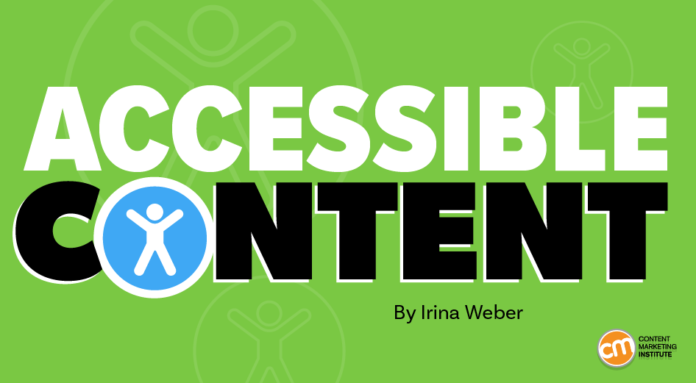Create your very own Auto Publish News/Blog Site and Earn Passive Income in Just 4 Easy Steps
Your content is only perfect when you make it accessible to everyone.
Google regularly introduces new accessibility features and updates to improve the accessibility of digital content, but marketers shouldn't just rely on third-party sites to break down barriers so everyone can enjoy your content.
The Web Content Accessibility Guidelines provide a foundation based on four principles that relate to the way people interact with content – operable, perceivable, robust and understandable. For example, a visitor might use a keyboard instead of a mouse, or someone might use voice commands to navigate a website. Viewers might use screen readers to have the content read to them, or a magnifier to read sections of the content.
To create accessible digital content and websites that are inclusive of all members of your audience and comply with accessibility laws, follow these practical and easy-to-implement tips:
1. Optimize title tags and headings
Make sure visitors can easily understand the structure of your content and find the information they need, whether they do it themselves or use voice assistants. Use clear and unambiguous page titles and headings, including relevant keywords, and make sure they are structured logically.
Use only one H1 tag. Keep your subheadings in sequential order (H3 after H2, etc.) and describe the content precisely. For example, use “Things to know about accessible content” instead of “Things to know” as your H2 subheading. This approach helps visitors know what to expect from each section of the content.
2. Create accessible tables
Tables in text can be difficult for screen readers to interpret. To make your tables accessible, don't copy and paste them from other documents, and don't paste them as image files. Use Cascading Style Sheets (CSS) to create them so voice assistants can easily read them.
3. Use descriptive anchor text for links
Read these two statements:
- Click here to learn more.
- For more information, see the WCAG standards.
The first option says almost nothing. The second – and better – choice describes what the user can expect when they click on the link.
Avoid general expressions in your anchor text, use a target keyword when appropriate, and be concise.
4. Add descriptive alternative text for images
Descriptive alt text helps search engines interpret image content, allows visually impaired people to understand what is shown, and potentially improves your website's visibility and ranking on Google. Write alt text for every image and video posted on your website and social media channels. Add captions for content posted on sites like Instagram Reels that don't have an alt text option.
Here's the alt text used to describe this image in a recent article from the Content Marketing Institute: “The ebook headline in this example from OptinMonster is straightforward: 50 clever ways to segment your email list.” The alt text describes the image (ebook headline) and the reason for including it (straightforward).
If the image is a logo, write “[company name] Logo.” Be as specific as possible. For example, instead of describing an image as “business insurance,” state the type of insurance.
5. Add public sitemap
Sitemaps allow visitors to quickly find the content they need and help search engines index your pages.
An XML sitemap generally gets the most attention because it's helpful to search engine crawlers, but an HTML sitemap gives visitors a clear, easily accessible overview of the most important pages. It's usually presented in a clickable format and placed in the footer, making it easier for users to navigate your site.
Here is an excerpt from fashion company Mango's publicly available sitemap. It highlights the women's department and details the types of clothing, shoes and accessories available, as well as plus-size categories.

Make sure your site includes both an XML and HTML sitemap.
6. Make social media content accessible
Many marketers prioritize making their websites accessible but neglect their social media channels. Some are hesitant to invest time in social media accessibility because it is not required under WCAG 2.1 standards. However, considering that 85% of Gen Z say social media influences their purchasing decisions, publishing accessible content is a smart move.
Follow the same tips you would for your website content – add captions and transcripts for videos and alt text for images, like this one We Rate Dogs used in their Instagram post about Pioppi: “A blue Staffy stretches his head over a piece of furniture, front paws resting on a piece of white fabric. His ears are pricked up and his eyes twinkle with a hint of mischief as he smiles at you with a closed-lip grin.”

You should also consider including a sign language interpreter in your videos and events, as they may be more helpful in localizing the conversation or supplementing the automatically generated transcripts.
Write accessible hashtags by capitalizing each word, like #MyCanyon, #ChelseaSodaro, #CanyonSpeedmax, #Triathlete, and #Triathlon in the post below. This makes it easier for screen readers to pronounce each word individually.

Don't use too many emojis. Voice assistants read each emoji out loud. For example, hearing 10 emojis in a row would be a challenge for any user.
For more information on social media accessibility, see this guide from the UK's Royal National Institute of Blind People.
7. Use accessible language
Your words are just as important as the organizational structure of your content. Precise language and a well-structured format ensure that the content is easy for everyone to understand.
The Website Accessibility Initiative guidelines state that you should use clear and simple language, or provide a simplified version. If you must use unusual words, phrases, expressions and abbreviations, explain them.
Other suggestions include using bullet points, highlighting text, and specifying the language of the content using the “lang” attribute in HTML.
You can use tools like Grammarly or Hemingway Editor to simplify the content.
8. Create accessible calls to action
Don't forget to create accessible CTAs that encourage everyone to take the next step. To do so, follow these tips:
- Write descriptive and action-oriented texts.
- Consider color contrast. The minimum ratio should be 4.5:1 so most people can read the text, but this varies depending on text size or WCAG compliance level. Use this contrast checker to see if your CTA button meets accessibility guidelines.
- Place your primary CTA above the fold so users can see it without scrolling down the page.
- Adjust the size and placement of your CTA in the mobile version to ensure it remains effective.
Regularly check your content for accessibility
To evaluate your website's performance, you can use free website accessibility checking tools like Accessibility Checker or Google Lighthouse. Every time you make changes or add content, you should make sure the update is accessible.
As shown in this screenshot of an audit of www.Paralympics.com, the Accessibility Checker gives the site a score out of 100, determines whether the site complies with regulations, and highlights specific accessibility issues.

You can also ask users with disabilities to test your website in your reviews. Post an accessibility commitment on the website and indicate how users can request accommodations.
In today's world, it's important to understand that accessibility is not a choice, it's a must. When you create accessible online content, you help create a more inclusive online environment where everyone has access and can participate.
All tools mentioned in this article are suggested by the author. If you have a tool to suggest, share the article with a comment on social media.
Register to attend Content Marketing World in San Diego. Use code BLOG100 to save $100. Can't attend in person this year? Check out the Digital Pass for access to on-demand session recordings of the live event until the end of the year.
HANDPICKED RELATED CONTENT:
Cover photo by Joseph Kalinowski/Content Marketing Institute
Create your very own Auto Publish News/Blog Site and Earn Passive Income in Just 4 Easy Steps







